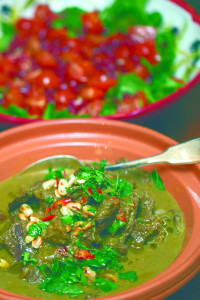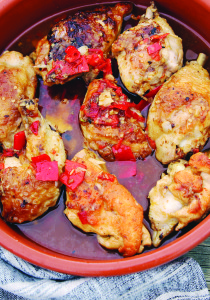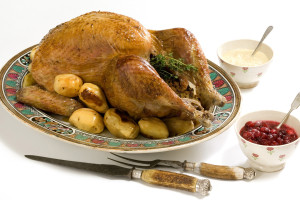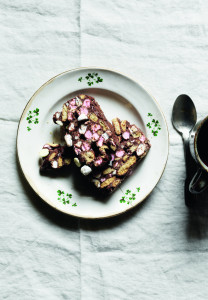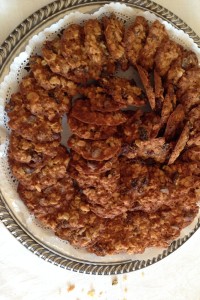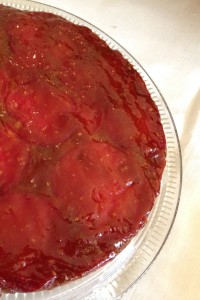There’s always a big flurry of new cookbooks published in time for the Christmas pressie market. You may already have one or two but if perchance you still have a couple of spare gift tokens hanging around, swing by your local bookshop they may have some special after Christmas offers. Here are a few of my favourite 2015 titles.
Several exciting new voices are emerging on the food scene. Anna Jones first book A Modern Way to Eat published in 2014, really piqued my curiosity. The sequel A Modern Way to Cook is one of my stand out books of the year.
Olia Hercules, another hot new talent, who brings us a taste of little known East European food . In her new book Mamushka, she casts a spotlight on the food of her native Ukraine and neighbouring countries whetting our appetites with her evocative prose, charming reminisces and super delicious recipes. She completed a diploma in Leith’s in London, did a spell in Italy and an inspirational stint with Yotam and Sami at Ottlenghi in London. Then it was home to record her mum and grandma’s recipes……she followed them round the kitchen with a scales and measuring spoons in an effort to accurately record their pinches, handfuls and glugs of this and that. I loved this fascinating and enchanting book.
Sabrina Ghayour, a self-taught chef is yet another beauty. Her debut cookbook Persiana has become an instant classic. She was named by the Observer Food magazine as one of the Rising Stars of 2014 and the Evening Standard named her as one of the 1,000 most influential people in London. Sabrina focuses on Persian and Middle Eastern Cooking.  Page after page of tempting, fresh tasting recipes that made me want to dash into the kitchen and roll up my sleeves. If you haven’t already discovered Sabrina, she’s another one to watch and her book Persiana is definitely worth parting with one of your precious gift tokens for.
I love anything Nigel Slater writes and his latest A Year of Good Eating Kitchen Diaries iii doesn’t disappoint. I also loved Sally Clarke’s 30 Ingredients. She’s a beautiful cook – recipes for the sort of food we really enjoy.  Alice Waters’ new book, My Pantry which she wrote with her daughter Fanny Singer is a sweet collection of essays and recipes. A charming little book where they share the simple building blocks that they use to create comforting impromptu meals all year round.
Tartine, Techniques and Recipes by Cortney Burns and Nicolaus Balla is another of my books of the year. Bread baking buffs will already have Tartine, Tartine Bread amd Tartine No. 3, but this book is quite different. Here Cortney and Nicolaus focus on fermented and pickled foods and share the secrets of the experimental journey they’ve been on for over a decade. Last time I was in San Francisco, they took me through the kitchen and pantry where they’re were all manner of things bubbling in barrels and jars in every corner. They were breathless with excitement about their discoveries and the book they were writing and now they have accepted our invitation to join us for the Kerrygold Litfest this year from May 20th -22nd 2016. www.litfest.ie
According to Tom Tivnan – features editor of trade magazine The Bookseller, the biggest trend so far this year are so called ‘clean eating cookbooks’. Cookbook sales are up this year by 10% plus. An astonishing 13,000 cookbooks were published world of which 1,800 were aimed at the so called ‘healthy eating brigade’. 8/10 books sold in 2015 was aimed at this market.
Ella Woodward’s Deliciously Ella has been the runaway success of the year.
On the Irish publishing scene, there have been several ‘stand out’ books this year. Rachel Allen’s new book Coast to accompany her coastal cooking series has tremendous appeal as has the long awaited Cooking at the Ballymore Inn by Georgina O Sullivan. Simple and delicious recipes loved by devotees of Barry and Georgina’s Inn in Ballymore Eustace in Co Kildare.
The K Club Cookbook from producer to plate is an elaborate production,  a handsome hard back which would make a super present for a keen ambitious cook. Donal Skehan’s star continues to rise. His  newest book Fresh has also been warmly received. Last but not least, a book closely connected to rural life, the Irish Country Women’s Association Book of Home and Family, has been a tremendous success. If you haven’t already got a copy, seek it out for its selection of time honoured favourites.
Georgina O’ Sullivan’s Penang Beef with Fresh Green Chutney
Make this a day or two ahead and the flavours will settle and improve, and it can be kept in the fridge. The tamarind adds a slightly sweet-sour flavour to curries. It’s sold two ways, in blocks of pulp which needs to be mixed with warm water and strained to remove the hard black seeds, or in jars as a concentrated paste.
Serves 8-10 /1 hour preparation and 1½ hours to cook /a little effort
2-3 tablespoons oil
2-3 large onions, finely chopped
3kg shoulder/chuck Irish beef, well- trimmed, cut into finger size strips
Spice Paste
3 cloves garlic, chopped
2 tablespoons fresh ginger, chopped
1 tablespoon lemongrass, chopped
3 red chillies, chopped
rind & juice of 2 limes
2 teaspoons sugar
100ml tamarind liquid
half can anchovies
Spices
1 tablespoon coriander seeds
1 tablespoon cumin seeds
1 tablespoon turmeric
100g peanuts, roasted & chopped
2 x 400g cans coconut milk
1 X 400g can chopped tomatoes
salt & black pepper
Fresh Green Chutney
250ml Greek-style yogurt
2 tablespoons mint
2 tablespoons coriander
2 green chillies, chopped
salt
Start with the onions: in a large pan heat a tablespoon of the oil and brown the onions really well. If they are browning too quickly, add a splash of water and continue cooking (you don’t need more oil). When the onions are browned, transfer to a large deep casserole.
Sauté the beef in the same pan with the remaining oil. Don’t overcrowd the pan. Transfer the beef as it browns to the onions in the casserole dish.
Next blend the spice paste: place all the ingredients in a processor and whiz for a minute. Remove and add to the beef and onions. Then, in a small pan, roast the coriander and cumin seeds, grind in a coffee/spice grinder and add to the casserole with the turmeric, peanuts, coconut milk, tomatoes and seasoning, cover and cook gently for 1 hour 30 minutes or until the beef is tender. Taste for seasoning: you want a good balance of flavours – hot, sour, sweet and salty – garnish with chopped fresh coriander, extra red chilli and peanuts.
To serve: this curry goes well with basmati rice or flatbread and it goes especially well with fresh green chutney (see overleaf for recipe).
To make the chutney place the yogurt in a bowl. Put the herbs, chillies and salt in the processor with 1 tablespoon of the yogurt. Whiz to a paste, then stir the mixture through the remaining yogurt in the bowl and taste for seasoning.
Â
Georgina O’ Sullivan’s Cumin Spiced Chicken
When cooking this dish, the size of pan is hugely important: if it’s too large, the cooking liquid will evaporate and you’ll have very little sauce at the end of cooking time. If it’s too small, then the flavours won’t have room to mingle. Ideally, the pan should hold all the ingredients comfortably. Over time it is good to build up a variety of different sized pans; sauté pans with lids that are flameproof are the most useful.
Serves 4
30 minutes plus cooking time/easy
                  Â
1 large Irish free-range Irish chicken
3 tablespoons olive oil
3-4 red chillies, chopped
4-5 cloves garlic, chopped
1 tablespoon cumin seeds, toasted
1 tablespoon flour
salt & black pepper
450ml stock or water
Start by cutting the chicken into 8 pieces. If you have the time, use the wing tips and backbone to make some stock. Set the oven to Gas 4/180˚C/350°F. Heat a pan with a tablespoon of the oil, add the chillies and garlic and cook gently for a few minutes, set aside. Grind the cumin seeds in a spice grinder or mortar and pestle, then take half the cumin and add to the flour in a bowl with the seasoning and mix well. Add the chilli and garlic mixture to the remaining cumin in the mortar and pestle and mix to a paste.
Next coat the chicken pieces in the cumin-seasoned flour, heat the remaining oil in a large pan and brown the chicken on all sides. Add the spice paste and stock, mix well, cover the pan and cook in the oven for 40 minutes, until fully cooked: digital probe 75ËšC. Check the seasoning and serve the chicken with rice, alongside a bowl of mixed salad leaves.
Sally Clarke’s Spiced Pumpkin, Tomato and Chickpea Stew
Although this is a rustic dish, and should therefore look a little ‘homely’ when presented, it is advisable to take care when slicing the vegetables, so that the individual ingredients look uniform in shape and size.
2 kg pumpkin or squash, blue hubbard, crown prince, onion squash or similar
1 tsp cumin seeds
1 tsp coriander seeds
½tsp yellow or black mustard seeds
4 cardamom pods
100ml vegetable or light olive oil
2 cloves garlic crushed to a cream
1 small green or red chilli, finely chopped (with seeds if extra heat is preferred)
1 large onion, peeled and finely sliced
2 sticks celery, finely sliced on the angle
1 fennel bulb, finely sliced
1 tsp salt
1 litre vegetable or chicken stock
½ bunch coriander, washed, leaves kept whole and stalks finely chopped
4 large tomatoes
350 g cooked chickpeas (canned are fine)
Large handful of flat-leaf parsley, roughly chopped
Wash the pumpkin or squash and cut into large wedges. Remove the tough outer skin and the hard seeds. Cut into pieces the size of a walnut.
In a small pan gently heat all the spices together for a few minutes or until they are fragrant. Do not allow them to burn. Remove the husks of the cardamom and add the seeds to the remaining spices. Crush them together in a pestle and mortar or grind in a spice grinder.
Heat the oil and spices together in a large, heavy-based pan with the garlic and chilli, over a medium heat, stirring continuously to avoid burning.
When the oil starts to become aromatic (approximately 1 –2 min – utes), add the pumpkin, onion, celery and fennel, stir well, coating everything in the infused oil. Add salt and cook together for a few minutes until the vegetables begin to soften. Add the stock and the chopped coriander stalks and cover with a lid. Simmer for up to 20 minutes or until the vegetables have become tender throughout.
Meanwhile blanch the tomatoes for a few seconds in a pan of boiling water. Remove to a bowl of iced water, then peel.
Roughly chop the tomatoes and add to the stew with the chickpeas and continue to simmer for a further 5-10 minutes.
Taste for seasoning and add the parsley and coriander leaves before serving alongside steamed rice, crushed potatoes, baked polenta or just by itself as a robust soup.
Sally Clarke’s Campari, Clementine and Vanilla Sorbet with Clementine Zest Madelines
For the sorbet
100ml water
200 g caster sugar
½ vanilla pod, split lengthwise
600ml freshly squeezed clementine juice (15 –20 clementines)
150ml Campari
For the madeleines
Zest of 3 clementines
2 eggs
110 g caster sugar
110 g flour, plus extra for preparing the tin
90 g melted butter, plus extra for preparing the tin
To make the sorbet. Bring the water, sugar and vanilla pod to the boil and simmer for 5–10 minutes or until some of the vanilla seeds have been released. When cool, scrape a few more seeds into the syrup, rinse the pod and keep for another use. Add the clementine juice to the syrup and then the Campari. Stir well and pour into an ice cream machine and churn following the manufactuer’s instructions. Just before it is firm, scoop into a freezer container and freeze for up to 1 week, although this sorbet will be best served within a few hours. Serve with a warm madeleine on the side.
To make the Madelines
Clementines are not as easy as oranges to zest – as they are softer and smaller – it is tricky to get any ‘purchase’ on the fruit whilst grating the rind. The important part is not to collect any pith as you grate, so slowly and gently does it. Lightly whisk the eggs and sugar with the clementine zest until very frothy. Using the whisk, fold in the sieved flour and then the cooled butter. Leave to rest for up to 30 minutes, covered in a cool place.
Preheat the oven to 180˚C/350°F/gas mark 4. Brush the madeleine moulds generously with soft butter, sprinkle with flour and knock out the excess. This will ensure that the little cakes, once cooked, fall out of the moulds with ease. With a dessert spoon or large teaspoon, scoop the filling into the moulds, almost to the rims. Bake for 10–12 minutes, or until they are puffed and golden. Leave to cool for a few minutes then tap them out of the tin and serve as soon as possible
Bar Tartine’s Overgrown Garden Pickles
Turn to this recipe in late summer when your garden goes into overdrive or when there is a deal on the ugly but delicious vegetables at the farmers’ market. It’s a simple technique that can be used for almost any vegetable, resulting in a glut of pickles to enjoy well into the winter months.
Makes 11.5 litres
Enough whole vegetables such as cucumbers, (flower ends removed), summer squash, onions, carrots, beets, green tomatoes, green beans to fill an 11.5 litre container
280 g (2 cups) kosher salt
7.5 litres (14 pints/8 quart) water
8 garlic cloves
4 shallots, peeled
5 serrano or jalapeno chillies, or any hot chillies from the garden, stemmed
2 bunches of fresh dill
Fresh herb sprigs such as basil, tarragon, parsley or marjoram for garnish
Fennel oil or extra virgin olive oil for garnish
Put all of the vegetables in an 11.5 litre non-reactive container. In a separate non-reactive container, dissolve the salt in the water to make a brine. Transfer about 480 ml (18 fl oz/2 cups) of the brine to a blender; add the garlic, shallots and chillies; process on high speed, pour the puree into the remaining salt brine and stir to mix well. Add the dill bunches to the vegetables, then pour the brine over them. Top the vegetables with a weight to keep them submerged in the brine. Seal the container, using a lid with an airlock, if you have one. If you have sealed it without an airlock, open the container every few days or so to release carbon dioxide build up and check for mould. Place in a clean, well-protected low light area with an ambient temperature 16-20C/60-68F until the pickles taste sour, about 1 month. Refrigerate for up to a year.
To serve – slice the pickles into bit size pieces and return them to the brine. Refrigerate until serving, for up to one year. We like to garnish these pickles with torn garden herbs and fennel oil.

